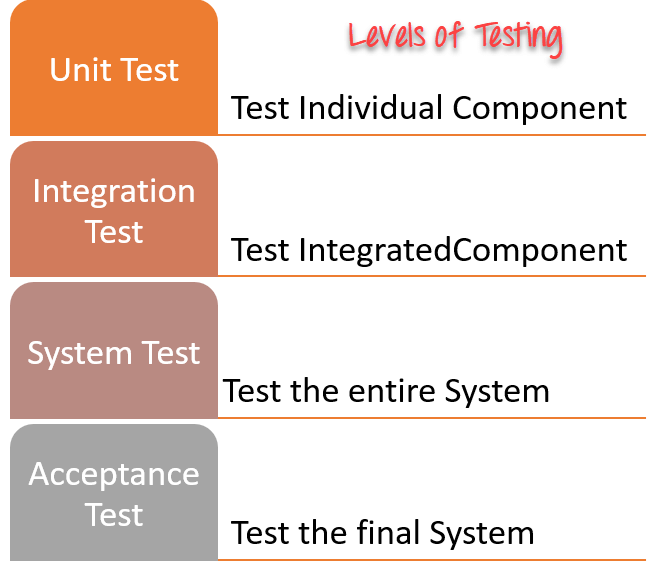TESTING YOUR SOFTWARE
What is software testing?
To begin with “testing”, testing is the last step before a product is released to the public. Examining, analysing, observing, and evaluating many aspects of a product are all part of this process.
Software testing is a technique for determining whether the actual software product meets the specified requirements and ensuring that it is defect-free. It entails the use of manual or automated methods to evaluate one or more properties of interest by executing software/system components. In contrast to actual requirements, software testing’s goal is to find mistakes, gaps, and missing requirements.
To put it another way, software testing is the process of identifying flaws in a finished product. It also determines whether the actual results match the predicted outcomes and assists in the detection of faults, missing requirements, or gaps.
Why to use software testing:
Software testing is important because it allows any faults or flaws in the software to be found early and fixed before the software product is delivered. A well-tested software product provides dependability, security, and excellent performance, which saves time, money, and improves customer satisfaction. Software flaws can be costly or even deadly, thus testing is essential. Software flaws have the ability to cause monetary and human losses, and there are numerous examples throughout history.
Many start-ups fail to test their products. They may claim that their limited budget is the cause for their failure to take such a crucial move. They believe it will have no significant impact. It must, however, be top-notch in order to establish a strong and positive initial impression. And, in order to do so, the product must be thoroughly tested for defects.
Similarly, established businesses must preserve their clientele and their image. As a result, they must ensure that the end-user receives perfect items. This problem would necessitate some network troubleshooting, doing this by over self is hard so we can take the help of the experts by clicking here .
Let’s look at some of the reasons why software testing is so important in software development,
- Boost Product Quality:
Only when the product delivered is perfect can a company provide value to its customers. To accomplish so, businesses must ensure that users do not encounter any problems while utilising their product. Making your goods bug-free is the fool proof approach to do it. Before delivering a product, companies must focus on testing apps and fixing any flaws that are discovered during testing. The quality of the deliverable improves when the team fixes issues before the product reaches the client.
2. Compatibility:
Customers no longer work exclusively on large desktop computers. Testing a product’s device compatibility is essential in today’s mobile-first world. Consider the case where your company created a website. The tester must see if the webpage works on various device resolutions. It should also be compatible with a variety of browsers.
3. Security:
Customers are bound to divulge some sort of personal information when they utilize the product. Before the software is deployed, security testing is required to prevent hackers from gaining access to this information. When a company follows a thorough testing procedure, it ensures a safe product, which helps customers feel safe while using it. Payment information is required by banking applications and e-commerce stores, for example. It can result in enormous financial loss if the developers do not repair security-related flaws.
Different testing strategies:
The 4 main different testing strategies are Unit testing, Integration testing, System testing and Acceptance testing which are used in different ways as per over needs.

Let’s discuss each of them in detail,
- Unit testing:
Unit testing is the most fundamental sort of testing. Unit testing seeks to check each component of software by isolating it and then doing tests to show that each component is proper in terms of meeting requirements and performing the desired functionality. This type of testing is done from the very beginning of the development process, and it’s often done by the developers themselves before the product is handed over to the testing team. The benefit of finding software flaws early each day is that it reduces software development risks, as well as time and money spent having to go back and fix basic faults in the programme after it has been completed.
2. Integration testing:
Integration testing is putting different pieces of a system through their paces in order to see if they perform well together. Any flaws in the way the units interact can be found by testing them in groups. Testers can use either a bottom-up or a top-down integration strategy to see how different components of the system interact at their interface. In bottom-up integration testing, higher-level combinations of units (called modules) are tested in increasingly complicated scenarios, building on the results of unit testing.
3. System testing:
As the term implies, the entire software product is tested to ensure that it fits the required requirements. System testing is critical because the program is almost ready to ship and can be tested in a similar environment to what the user will encounter once it is installed. System testing allows testers to guarantee that a product meets business requirements and functions properly in its operating environment. A specialized testing team is usually responsible for this type of testing.
4. Acceptance testing:
Finally, acceptance testing is the stage of the software testing process at which a product is granted approval or disapproval. This sort of testing determines whether the system meets end-user criteria and is ready for deployment. The testing team will utilise a range of methods to test the programme, including pre-written scenarios and test cases, and will utilise the results to suggest ways to improve the system. Acceptance testing can encompass everything from discovering spelling typos and cosmetic faults to detecting flaws that could cause a big application issue.
Types of software testing:
Let’s discuss the top software testing types,
- FUNCTIONAL TESTING:
The process of assessing the functionality of a software application is known as functional testing. A functional test yields pass or fail result because either a feature works as intended or it does not. The goal of functional testing is to ensure that the software application’s requirements have been met. It’s crucial because functional testing determines whether or not a program is ready to be delivered to end users. While software engineering has progressed over the last decade, functional testing is still an important component of quality assurance.
2. Black box testing:
Testing as though the programme were a black box is known as black-box testing. Black-box testing is one of the most prevalent types of testing, and it’s also a term for an entire category of testing. You only care about inputs and outputs when you undertake black-box testing. It makes no difference how the actual outputs are generated. You have no idea what the code is or how it works; all you know is that for a certain set of inputs into the software, a certain set of outputs should be created. Because it is mostly neutral, this method is used for the majority of testing. Either it works or it doesn’t work.
3. White box testing:
When you understand some of the system’s internals and possibly have access to the source code, you can utilise that knowledge to inform your testing and what you target. The opposite of black-box testing is white-box testing. White-box testing gives you an understanding of what’s going on inside the software. I disagree with the term “white-box” when it comes to unit testing. Unit testing isn’t the same as proper testing.
4. Automated testing:
Any testing in which the execution of the test and the verification of the findings is automated is referred to as automated testing. So, you could automate web application testing by executing scripts that open a web page, input data, push buttons, and then check for results on the page. You may also automate API testing by building scripts that call the API with different input and then check the results. Because manually running through test cases over and over again may be tedious, error-prone, and costly, more and more testing is shifting towards automated testing.
5. Regression testing:
This leads us to regression testing, which is simply testing to ensure that the system continues to function as it did previously. The goal of regression testing is to ensure that the software’s functionality does not deteriorate. This is especially relevant in agile development approaches, as software is produced gradually and there is always the risk of breaking existing features by adding new ones. Regression tests make up the majority of automated tests. In fact, one might argue that all automated tests are regression tests because the whole point of automating a test is to be able to execute it numerous times.
Ways of testing:
There are many ways of testing but mostly we use 2 main ways Manual and Automatic.
- Manual:
Manual testing refers to the process of manually testing software without the use of any automated tools or scripts. In this scenario, the tester assumes the role of an end-user and tests the software for any unusual behaviour or bugs. Unit testing, integration testing, system testing, and user acceptability testing are examples of manual testing steps. To guarantee that testing is complete, testers utilise test plans, test cases, or test scenarios to test software. Exploratory testing is a type of manual testing in which testers explore the software to find flaws.

2. Automatic:
When a tester writes scripts and uses another piece of software to test a product, this is referred to as automation testing. A manual procedure is automated in this method. Automation Testing is used to swiftly and repeatedly re-run test scenarios that were previously conducted manually. Automation testing is also used to evaluate the application from a load, performance, and stress standpoint, in addition to regression testing. In comparison to manual testing, it increases test coverage, improves accuracy, and saves time and money.
Benefits of software testing:
- One of the most significant advantages of software testing is its cost-effectiveness. Timely testing of any IT project allows you to save money in the long run. It is less expensive to correct issues discovered early in the software testing process.
- Software testing’s most vulnerable and sensitive benefit is security. People are looking for products that they can trust. It aids in the early detection of hazards and issues.
- Product quality is a must-have feature for any software product. Testing guarantees that buyers receive a high-quality product.
- The primary goal of every product is to provide customer satisfaction. The optimal user experience is ensured by UI/UX testing.
- Integrating your software systems gives you a single, comprehensive perspective, which makes decision-making easier. It eliminates the need to switch between programs in order to access data that could influence your judgments.
- You can increase the productivity of your operations by integrating applications that use the same data sources. This is especially important when the same data is put into different software systems many times. Processing is easier and faster because there is just one point of data entry and no need to navigate between multiple software applications.
- Integrating systems that streamline any aspect of your end-to-end sales process and increase order fulfillment rates can boost your entire sales potential.
How to resolve the software testing issues:
If you are looking for a firm that can help you improve the quality of your IT application by providing independent software testing services? Are you still unsure how to improve the quality and performance of your IT application after conducting in-house research for testing solutions? You no longer need to invest tens of thousands of dollars on a testing crew and methodology. Instead, you can employ cost-effective solutions from a leading software testing service provider known as “benchmark it services.”

(Image reference: https://www.benchmarkitservices.com.au)
This business can offer you the best solutions and provide you more control over the process, leading in increased productivity for your current teams and releases. Problems may occur at any point in the network, if we feel stuck any point, we can solve it simply by taking an expert advice like “BENCHMART IT SERVICES” by clicking here .
Application Testing, Performance Testing, Test Automation, Security Testing, Usability Testing, Accessibility Testing, Consulting, and Workshops are among the core services offered by “Benchmark it services.” This is a software testing and quality assurance firm that focuses on minimizing risks, increasing efficiency, and strengthening businesses to solve quality issues.
Software testing tools:
There are many software testing tools currently in the market some of them are,
- HP Quick Test Professional
- Selenium
- IBM Rational Functional Tester
- SilkTest
- TestComplete
- Testing Anywhere
- WinRunner
- LoadRunner
- Visual Studio Test Professional
- WATIR
“X-TECH BUY” is the largest market hub where we can buy all of these types of software packages.

This is the location where we may obtain all of the necessary hardware and software components. Purchasing them is a simple process that can be completed by shopping on their website, https://www.xtechbuy.com/. This shopping website not only had these we can buy any type of it related hardware and software accessories. If you are confused which tool to use or need help using any tool “Computer Repair Onsite (CROS)” is always available to its customers to fix their problems fast and perfectly. You can get in touch easily with “Computer Repair Onsite (CROS)” here.


